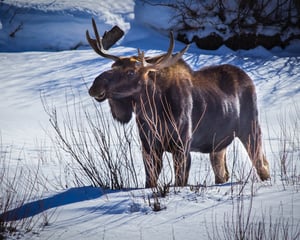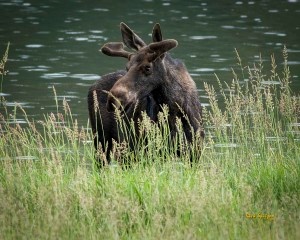
Only 20 years ago seeing a moose in Colorado was rare. But thanks to successful relocation efforts by Colorado Parks and Wildlife (CPW), upwards of 3,000 moose now call Colorado home. CPW introduced Shiras moose (Alces alces shirasi) in 1978 and 1979 in North Park, which still has the highest concentrations. Over forty years later, even here in the Eagle Valley at the southern extent of their range, moose are thriving.
Where Are They?
In winter you can spot moose on open south-facing slopes where less snow allows moose to browse shrubbery, like near the Bighorn Trail in East Vail. Sometimes they pick unexpected habitat, like the moose frequenting Dowd Junction along I-70 this February or the big fellow that hung out under Gondola 1 at Vail last year. But as snow melts, moose seek their favorite food – lush riparian plants along marshy areas near streams, lakes, and ponds. In summer, the Piney Lake area has reliable moose viewing, as do many of our trails, including Cross Creek, Grouse Creek, and Martin Creek. But read on before you or your dog approach a moose.
Think BIG
It’s a treat to see one of these massive mammals in the wild. Moose can weigh up to 1,800 pounds and be 10 feet long and seven feet tall at the shoulder. Males can have antlers up to five feet wide and weighing over 60 pounds! To reach that size, moose consume 50-80 pounds of food per day. In the wintertime that’s mostly twigs and branches from willows, aspen, and other deciduous plants – in fact, the name “moose” comes from the Algonquin “mus” or “moos,” meaning “twig-eater.”

Swimming Anyone?
Moose have hollow hair that helps keep them insulated in the winter and buoyant when swimming. They can swim for hours, and may dive up to 20 feet deep while holding their breath for up to a minute.
What Is That Thing?
Adding to a moose’s unique appearance is an appendage hanging from its chin, called a dewlap or bell. Both males and females have dewlaps, but males’ can be up to 20 inches long. Scientists don’t really know its purpose. While bull moose have been observed “chinning” cows with their dewlaps during mating season, which transfers the bull’s scent, another theory is that dewlap size, like antlers, indicates dominance to other bulls.
Who Scares a Moose?
Wolves and grizzlies eat moose, but don’t yet frequent our region. Moose fall victim to collisions with motor vehicles – and the vehicles and their occupants don’t fare so well either, so watch diligently when driving. CPW issues a handful of moose tags to hunters each season. But perhaps the biggest threat to moose in our region is climate change – the same hollow-hair coats that keep them warm in the winter and buoyant in water also make them overheat when temperatures rise.
Gentle Giant? Guess Again:
What’s the most dangerous wildlife in the Eagle Valley? Surprisingly, the humble moose has been responsible for more attacks on humans than any predator species found in Colorado! Moose may look slow, but when they decide to move, they can run 35 miles per hour – that’s 7 miles per hour faster than the fastest Olympic sprinter. And moose will stand their ground and charge when they feel threatened – especially in late spring and summer when protecting their young, and in fall during the mating season. If you have any doubts, check out this CPW video - Moose Attacks Are Increasing. CPW cautions that dogs are the biggest safety concern, since moose see dogs as wolves. CPW reports multiple instances of moose chasing dogs back to owners, with serious injury to owners and dogs. Because CPW’s priority is human health and safety, a moose that injures a human is usually euthanized – and who wants to be responsible for the death of such a magnificent animal? So, keep your dog on a short leash and don’t approach moose! Moose have good hearing, but limited eyesight – so make some noise when nearby.
Here’s hoping you get to see a mighty moose soon – just remember that they need their personal space, so grab your binoculars or telephoto lens, view from a safe distance, and enjoy!
Frances Hartogh is a Volunteer Wilderness Ranger with the Eagle Summit Wilderness Alliance.
About the Eagle Summit Wilderness Alliance
The Eagle Summit Wilderness Alliance is a local volunteer-led 501(c)(3)nonprofit organization committed to keeping wilderness wild in Eagle & Summit Counties. ESWA assists the US Forest Service in maintaining the Holy Cross, Eagles Nest, and Ptarmigan Peak Wilderness Areas.
Hike with Walking Mountains!
If you are interested in exploring your local backcountry trails with a guide, or learning more about the wildlife (and how to track them) or snow science of our valley, join Walking Mountains Science Center for half day snow shoe tours in the White River National Forest each Tuesday and Thursday. Programs include tracking programs and snow science hikes. For more information and to register visit www.walkingmountains.org/snowshoe.







